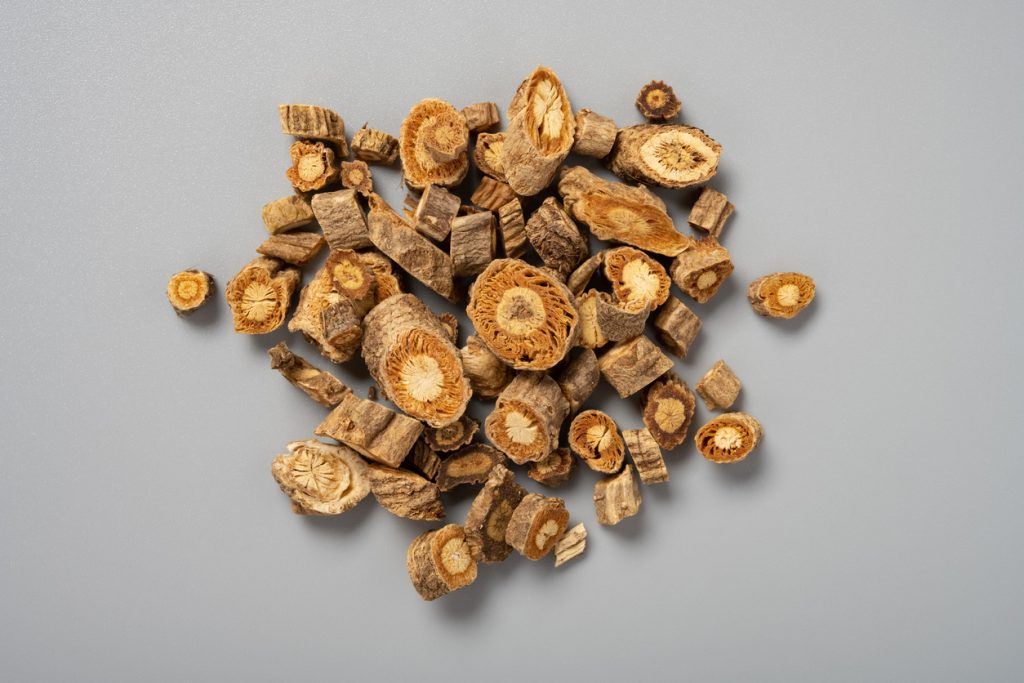Divaricate Saposhnikovia Root (Fang Feng)

What is Divaricate Saposhnikovia Root (Fang Feng)?
Divaricate Saposhnikovia Root (fang feng, 防风), also known as Radix Saposhnikoviae or Siler Root, refers the the root of Saposhnikovia divaricata, a perennial herb belonging to the family Umbelliferae. A long, cone-shaped plant that reaches a height of 6 – 12 inches, Saposhnikovia divaricata appears thicker as it enters the ground. The external surface of the plant is gray and wrinkly as well. Saposhnikovia divaricata often grow on grasslands, hills and gravel slopes. Distributed in China, Mongolia, Russia, Japan and South Korea, Saposhnikovia divaricata is resistant to cold and drought.
First recorded in Classic of the Materia Medica (Shen Nong Ben Cao Jing, 神农本草经) in the late Western Han Dynasty (around 100 BC), there are about 300 kinds of Chinese medicine prescriptions containing Fang Feng. In Spring and Autumn, people gather the roots of Saposhnikovia divaricata, have their fibrous roots and impurities removed and cut them into slices for medicinal usage. You can use them directly or carbonize them.
In Traditional Chinese Medicine (TCM), Fang Feng falls under the category of ‘Warm/Acrid herbs that release the Exterior’. Such herbs can treat the early stages of diseases that affect the upper respiratory tract, eyes, ears, nose, throat and skin. In TCM, it is believed that external diseases such as colds or allergies can only invade the body if the external environment overwhelms our wei qi (immune system). To counteract this invasion, such herbs can induce sweating to increase the flow of sweat to our capillary pores, which can expel the disease from the body.
Warm in nature, Fang Feng can help individuals with too much Cold in their body, such as those experiencing a Yin Excess or a Yang Deficiency, to restore a harmonious yin-yang balance. Pungent and sweet, Fang Feng can promote the circulations of qi and body fluids, slow down acute reactions, detoxify the body and has a tonic effect on the body by replenishing qi and blood.
Functions and Benefits of Divaricate Saposhnikovia Root (Fang Feng)
Traditional Chinese Medicine (TCM) shows that Fang Feng has the following health benefits.
Fang Feng can dispel Wind and release exterior pathogens, which helps to treat syndromes caused by exterior Wind-Cold, Wind-Damp and Wind-Heat. For example, the herb can help to relieve headache, body pain, fever, sore throat and thirst.
Also, Fang Feng can dispel wind to stop itching and treat skin diseases. For example, it is usually used for urticaria and itching caused by Wind pathogens. The herb is often combined with herbs that nourish blood and moisten dryness, such as Radix Angelica Sinensis and Dried Peony Root Bark to enhance its effectiveness in alleviating itching.
Fang Feng can dispel Wind-Damp and treat Wind-Damp arthralgia, which is usually manifested as joint pain and sinew spasms. The herb is also indicated for Exterior Wind and Interior Wind, Fang Feng can alleviate spasms, twitching limbs, stiffness in the nape, neck, back and arched back rigidity.
In addition, Fang Feng can address indigestion problems such as painful diarrhea with blood in stools, borborygmus and abdominal pain caused by disharmony in the Liver and Spleen.

How to Use Divaricate Saposhnikovia Root (Fang Feng)
The recommended daily dosage of Fang Feng is 3 – 9g.
Fang Feng is usually sold in the form of powder or capsules. Dried pieces of Fang Feng are available at some Asian markets and specialty stores.
Cautions and Side Effects of Divaricate Saposhnikovia Root (Fang Feng)
Fang Feng should not be used by individuals who are experiencing Yin Deficiency, Blood Deficiency or Heat signs associated with Yin Deficiency. If you are experiencing difficulty in passing stools or urine, nausea caused by rebellious qi or spontaneous sweating caused by Qi Deficiency, it is best to avoid this herb as well.
Do not consume Fang Feng together with Gan Jiang (Dried Ginger), Li Lu (Veratrum Root and Rhizome), Bei Xie (Rhizoma Dioscoreae Hypoglaucae) or Shan Zhu Yu (Fructus Corni).
Overdosing Fang Feng may result in side effects such as sweating, thirst, abdominal discomfort, nausea, vomiting, skin itching or erythema.
Summary
Here is a summary for Divaricate Saposhnikovia Root (Fang Feng):
- Herb name (Chinese): 防风
- Herb name (Pin Yin): fáng fēng
- Herb name (English): Divaricate Saposhnikovia Root
- Herb name (Botanical): Radix Saposhnikoviae
- Origin of species: Saposhnikovia divaricata (Turcz.) Schischk.
- Part(s) of herb used: Root
- Geo-specific habitat(s): North eastern parts of China, Eastern parts of Inner Mongolia
- Taste(s) & Properties: Pungent, sweet; Slightly warm; Administrates the Bladder, Liver and Spleen Meridians
- Actions: Relieves symptoms of influenza or related respiratory discomforts; Eases skin rashes; Helps to provide pain relief to those suffering from rheumatism
References
Kim, S. J., Chin, Y. W., Yoon, K. D., Ryu, M. Y., Yang, M. H., Lee, J. H., & Kim, J. W. (2008). Chemical constituents of Saposhnikovia divaricata. Korean Journal of Pharmacognosy, 39(4), 357-364.[Accessed on 7th January 2023]
Okuyama, E., Hasegawa, T., Matsushita, T., FUJIMOTO, H., ISHIBASHI, M., & YAMAZAKI, M. (2001). Analgesic components of saposhnikovia root (Saposhnikovia divaricata). Chemical and pharmaceutical bulletin, 49(2), 154-160.[Accessed on 7th January 2023]
Tai, J., & Cheung, S. (2007). Anti-proliferative and antioxidant activities of Saposhnikovia divaricata. Oncology reports, 18(1), 227-234.[Accessed on 7th January 2023]
Yang, M., Wang, C. C., Wang, W. L., Xu, J. P., Wang, J., Zhang, C. H., & Li, M. H. (2020). Saposhnikovia divaricata—An ethnopharmacological, phytochemical and pharmacological review. Chinese journal of integrative medicine, 26(11), 873-880. [Accessed on 7th January 2023]
Share this article on
